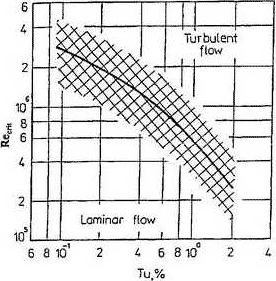Navigation by alphabet
A B C D E F G H I J K L M N O P Q R S T U V W X Y ZIndex
Forced Convection Around Immersed Bodies
DOI 10.1615/hedhme.a.000169
2.5.2 Forced convection around immersed bodies
V. Gnielinski, A. Žukauskas, and J. V. Žiugžda
A. Smooth flat plate
When a fluid of a uniform velocity flows over a plate with a streamlined leading edge, i.e. when the leading edge is sharpened, the stream adjacent to the plate is retarded, thus forming a laminar boundary layer. The thickness of the laminar boundary layer increases with the increasing distance x from the leading edge until a critical length xcrit is reached, where a transition to a turbulent boundary layer starts. The critical length is determined by the critical Reynolds number Recrit = u xcrit /ν, where u is the free stream velocity and ν the kinematic velocity of the fluid, Recrit depends, among other factors, on the degree of turbulence of the stream (usually expressed as the ratio Tu of the rms turbulent velocity fluctuations to the free stream velocity), the fluid type and the roughness of the plate (Žukauskas, 1989). Recrit may be higher if the degree of turbulence in the stream is low, whereas much lower values have been observed when the stream has a high degree of turbulence (Figure 1). A value of Tu = 1% is typical of ordinary flow conditions, giving an Recrit value of around 5 × 105.

Figure 1 Effect of level turbulence intensity (Tu) on the critical Reynolds number (Recrit) for a plate
For a flat plate with a streamlined leading edge both types of boundary layer exist, whereas for flow over a flat plate with an obtuse-angled or blunt leading edge only a turbulent boundary layer develops starting from the leading edge. Presser (1968) has investigated the influence of the shape of the leading edge.
(a) Laminar boundary layer
... You need a subscriptionOpen in a new tab. to view the full text of the article. If you already have the subscription, please login here